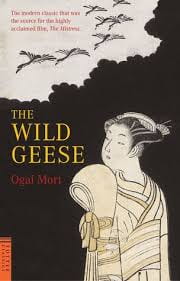What do you find interesting about the author’s use of motif/symbolism in their presentation of the character of Suezo?
In Chapter 6, pages 35 and 36, of the novel “The Wild Geese”, Ogai Mori delves into the conflict between the individual and the group, particularly that of individualist desires and socio-cultural expectations in Japanese society. Through using the motif of luxury and clothing, Mori interestingly presents Suezo’s desire to liberate from his familial obligations, living his ideal life with Otama within his own imagination – a recurring theme in this novel. By eliciting both distaste and sympathy for Suezo’s character, Mori reflects on the constraining nature of social moral obligations and its impact on one’s personal identity – driving us to question the extent to which following these obligations does more harm than good to societal and personal harmony.
Firstly, using Suezo’s admiration for luxury and clothing, Mori portrays Suezo’s desire to escape his obligations to his wife and children, and pursue his personal desire of being with his mistress, Otama. From a third person omniscient view, the narrator reflects on some men in Japanese society at the time being very ‘thrifty’, only ever ‘loosening their purse strings… for women’. The ‘wom[a]n’, in Suezo’s case, alludes to his mistress Otama, his individualist desires outside of his duties to his wife and children. Him ‘loosening’ his purses, which the narrator suggests as being rather ‘tight’ in the following line, introduces us to Suezo’s prioritisation of his duties – with his frugality perhaps being a symbol of his restraint and compliance with his moral familial duties,which are rather constraining or ‘tight’. However, Mori suggests that he finds escape from his rigid role as a husband and father, as men like Suezo find ‘a breath of fresh air’ when they can step out of their frugal spending. The image of taking in a ‘breath’ of an identity that is new or ‘fresh’ from his tight spending creates a sense of relief, as he can escape his familial obligations to spend time and his money with women like Otama. From a collectivist perspective, mainly Mori’s audience at the time, this presents him as being rather self-indulgent and a disloyal husband, yet Mori subtly elicits empathy for Suezo as we see him as someone with personal ambitions that make him happy. This is furthermore seen through the narrator claiming that Suezo’s ‘only hobby’ was ‘dressing’, with the luxury of clothing perhaps being a symbol of his desire to transform into another identity through wearing new layers of clothing, where he escapes the responsibility he has towards his family.
Nevertheless, Mori challenges our sympathies towards Suezo’s inner conflict through portraying his inability to share his luxurious spending on clothes. Suezo is suggested to have never let his wife, Otsune, ‘dress in a kimono to match his own expensive one’, presenting his character as being selfish – a view held commonly by groups in Japanese society towards those who break ‘wa’ – breaking the harmony in society for personal reasons. The kimono, a symbol of Suezo’s facade and ideal life he has with Otama, is one that he invests most of his time and money to build. Him not wanting to share this with his wife is perhaps a reflection of the clear line he draws between his familial duties and personal desires. Mori thus conveys a distinct, black and white perspective on collectivist and individualist attitudes in Japanese society, though not directly proposing one being better than the other. This challenges our sympathies towards Suezo’s actions; prioritising his appearance for Otama over his family is self-serving and ignorant, yet finding passion and happiness in this more luxurious, ideal life is what makes him seem more human, lifelike.
This is further seen when Suezo ‘denie[s]’ any costly item that Otsune wants, which further conflicts our sympathies as it could either be seen as Suezo’s projection of his confinement in his moral obligations towards his family through depriving them of sharing his luxurious personal desires which are ‘costly’ or rare – driving empathy for his character. Alternatively, Suezo could be an ironic representation of Otsune’s ‘giri’, refusing to spend luxuries on her and thus deprive her of personal freedom and her happiness, eliciting condemnation for his selfishness and ignorance. The use of motifs of clothing and luxury thus creates a cyclical image of how collectivist Japanese expectations influence personal desires, which Mori ultimately uses to question the extent to which these values truly bring ‘wa’, harmony, to individuals and groups in society.

